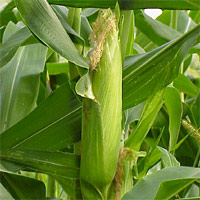Sweet Corn

Nothing says summer like freshly harvested, lightly steamed ears of sweet corn .
About This Plant
Sweet corn varieties include yellow, white, and bi-colored types. Because corn is wind-pollinated, it should be planted in blocks of at least four rows rather than in long single rows. By planting early, mid, and late-season varieties you can extend the harvest over several weeks. Plant corn on the north side of the garden to prevent it from shading nearby crops.
Site Selection
Select a site with full sun and well-drained soil. Prepare the garden bed by using a garden fork or tiller to loosen the soil to a depth of 12 to 15 inches, then mix in a 2- to 4-inch layer of compost and/or aged manure.
Planting Instructions
Plant corn directly outdoors after all danger of frost has passed and the soil temperature is about 60 degrees F. Corn requires a good deal of nitrogen for optimum growth, so work plenty of aged manure into the soil the previous fall and plan to fertilize with additional nitrogen during the growing season if necessary. Plant corn seeds in blocks of at least four rows with 2 to 4 feet between rows, sowing the seeds 1-1/2 to 2 inches deep and 6 to 8 inches apart.
Care
Thin the corn to stand 12 to 16 inches apart when the plants are 4 to 5 inches tall. Provide at least 1 inch of water a week. Control weeds with frequent shallow cultivation until the plants are knee high. Then apply a 3- to 5-inch layer of mulch. Watch for signs of nitrogen deficiency (yellowing leaves) and respond with quick side-dressings of a nitrogen-rich fertilizer such as fish emulsion. Contact your local County Extension office for controls of common corn pests such as corn earworms and European corn borers.
Harvesting
Sweet corn should be harvested when its ears are completely filled out and a pierced kernel shows a milky white liquid.
Sweet corn varieties (except for supersweet varieties) lose their sweetness soon after harvest. Immediately after picking prepare the ears for eating or preserving.






 Nothing says summer like freshly harvested, lightly steamed ears of sweet corn .
Nothing says summer like freshly harvested, lightly steamed ears of sweet corn .